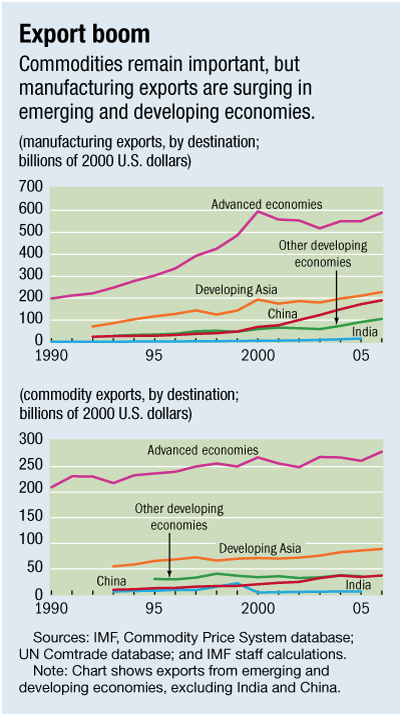
Typical street scene in Santa Ana, El Salvador. (Photo: iStock)
IMF Survey: Commodity Price Boom, Better Policies Spur Globalization
April 3, 2008
- Commodity boom more benefit to many developing economies than prior booms
- Manufacturing exports from developing economies on the rise, including to Asia
- Better institutions and external liberalization key to further integration
Emerging and developing economies have become significantly more integrated into the global economy in recent years, against the backdrop of soaring commodity prices and steadily improving institutions and policy frameworks, according to a new IMF study.

By historical standards, the current commodity price boom has been broad based and sustained, with many prices rising sharply (photo: Newscom)
DEVELOPING WORLD AND GLOBAL INTEGRATION
Published in the April 2008 World Economic Outlook and entitled "Globalization, Commodity Prices, and Developing Countries," the study says total trade (exports and imports) now constitutes 50-100 percent of GDP, and total foreign capital (assets and liabilities) ranges from 100 to 200 percent of GDP across developing regions.
At the same time, commodity prices have risen about 75 percent in real terms since 2000. Policy barriers to trade and financial flows have come down steadily. And the quality of institutions and macroeconomic management have improved in both commodity and non-commodity exporters.
The study, which covers a broad sample of regions and countries, examines this growing integration, with a view to assessing its sustainability. It focuses on the role of commodity market developments, as well as of changes in policies and institutions, in driving globalization in developing economies.
A new era
Although many developing economies continue to depend on commodity trade, their exports have become much more diversified in terms of both composition and destinations. The volume of manufacturing exports relative to real GDP has grown steadily across the developing world, with gains ranging from about 2 percentage points in the Middle East and Africa to more than 20 percentage points in Asia since the late 1980s.
Advanced economies remain the most important destination for exports, but buoyant demand across developing economies has also helped advance industrialization in a broad range of countries. In 2000 U.S. dollars, manufacturing exports to advanced economies have tripled since the early 1990s, whereas those to China have grown even more dramatically, albeit from a low initial level (see chart).
Manufacturing exports to other developing countries in Asia and elsewhere have also picked up. And commodity exports to China and other Asian countries have risen sharply, but even commodity exporters have stepped up their manufacturing trade.
At the same time, manufacturing sectors in developing economies have received sizable amounts of foreign direct investment (FDI). Developing economies have also become a more important source of FDI, including in the manufacturing sector.

The current boom
By historical standards, the current commodity price boom has been broad based and sustained, with the prices of many commodities—oil, metals, major food crops, and some beverages—rising sharply. However, different developing economies have reaped uneven benefits, reflecting differences in the composition and relative magnitudes of their commodity exports and imports. For instance, since 2000 the commodity terms of trade have risen by more than 40 percent in the Middle East but fallen slightly in Asia.
Commodity-exporting developing economies currently experiencing a boom have benefited from it more than from previous booms in a number of ways. Their median total export volumes have grown over 3 percentage points a year faster than in past booms, as have manufacturing exports. The rapid growth in manufacturing export volumes may have benefited from two policy shifts: in fuel exporters, less real appreciation than observed during past booms; in non-fuel commodity exporters, greater tariff reduction.
Also, output, FDI, and domestic investment have all accelerated, whereas foreign borrowing, especially by governments, has slowed relative to past booms.
Drivers of integration
Although commodity prices have substantial effects in the short term, the study implies that their longer-term contribution to trade and financial integration is relatively minor. In other words, commodity prices are not a key factor in the 26 percent long-term rise in developing countries' export volumes relative to GDP between the 1980s and 2000s.
Instead, nearly two-thirds of this increase in export volumes can be explained by better institutions, financial deepening, and reduced policy distortions, which include fewer exchange restrictions, lower tariffs, and diminished overvaluation. The rising integration of developing countries into the world economy also reflects greater trade openness in other developing economies, helping promote South-South trade.
These findings imply that even if commodity prices were to lose their buoyancy, integration is unlikely to be reversed. Continued improvements in institutional quality, financial deepening, fiscal prudence, and external liberalization will continue to be important drivers of integration. Nevertheless, many developing economies remain dependent on commodity exports, and increased diversification and further progress on reforms would improve their ability to withstand abrupt changes in commodity prices and support further integration into the global economy.
Comments on this article should be sent to imfsurvey@imf.org


